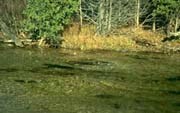
With 65 miles of Lake Michigan shoreline, 26 inland lakes and ponds, and four streams, fish are an important resource of Sleeping Bear Dunes National Lakeshore. There are 93 known fish species within the park. Some species, which were once common, such as the lake sturgeon and lake herring are now on Michigan’s List of Threatened Species. Other native species such as the brook trout and yellow perch, are also in decline. The introduction of exotic fish to the Great Lakes and their associated inland lakes, either accidentally or purposely, is a remarkable story of environmental impact. Sea lampreys were able to access the upper Great Lakes after the completion of the Welland Canal around Niagara Falls. They reached Lake Michigan by 1936 and soon devastated the native lake trout. The alewife, a fish from the Atlantic coast, was first noted in Lake Michigan in 1949. Since then it has dominated Lake Michigan with an estimated 50% of all of the fish biomass in the lake. This species is known for its periodic die offs and the resultant wind rows of dead fish along the beaches. Coho and chinook salmon along with steelhead (rainbow) trout were introduced to help reduce alewife numbers and to replace the dying lake trout fishery. Several new exotic species of fish such as round goby and ruffe have entered the Great Lakes from the ballast water of large ocean-going vessels. The impacts and changes that will occur from these introductions are just starting to appear. These introductions have all resulted in reduced native fish populations of lake trout, perch, lake herring and chubs. |
Last updated: April 10, 2015
